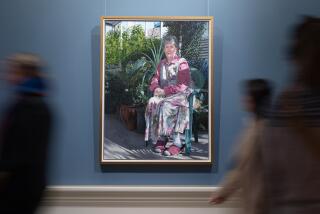Gone to Ballyvaughan, Her Ideal Irish Village : IRISH: Ideal Village
- Share via
BALLYVAUGHAN, Ireland — “The view from my front door is so lovely,” a woman here told me, “I don’t have to go to the films.”
I had an image of what I wanted--a small village on Ireland’s west coast where I could spend a few days, a village picturesque but not overrun with tourists, a village full of character and characters.
Furthermore, because I knew I would be tired by the time I landed at Shannon Airport, I wanted a destination I could reach easily within an hour or so by rental car.
There didn’t have to be a lot to do in this village, for I would create my own diversions. All I wanted was the chance to stroll around, down a few pints in some Irish pubs, chat with the locals and experience a slice of life in a village where nothing much happened.
After consulting with the experts at the Irish Tourist Board I decided that Ballyvaughan in County Clare fit the bill. As soon as I got here I knew I had made the right choice.
“How many people live in Ballyvaughan?” I asked one of the locals as soon as I arrived.
He paused for a moment, scratched his head and then answered slowly, “Well, I suppose there’s about 250. At least, that’s how many people you’d see at Mass on a Sunday in the winter.”
No doubt about it, Ballyvaughan was my kind of town.
The only problem was--there turned out to be so much to see and do in the village and vicinity that the amount of time I could devote to nursing those pints was sadly curtailed.
Lunar-Like Landscape
About an hour’s drive north of Shannon Airport on Galway Bay, Ballyvaughan sits on the edge of a fascinating lunar-like landscape known as the Burren, a treeless 100-square-mile area of rocks upon rocks upon rocks.
For more than 4,000 years man has carved a niche for himself here, and from these rocks has fashioned tombs and forts, churches, castles and cairns and miles upon miles of stone fences. Clamoring for attention are also a beautiful coast, the stunning Cliffs of Moher, prehistoric Aillwee Cave and tiny Ballyvaughan itself.
“Of all the towns in the Burren,” another woman said, “Ballyvaughan is the one that’s retained the most character and is the least spoiled.”
A third woman pointed out, “We’re only 3 1/2 hours from Dublin, so actually we’re very centrally located. Besides the sea, we also have good bars, music and plenty of places to stay. A lot of people use Ballyvaughan as a base, since this is definitely one of the most interesting areas to visit.”
The most popular place to stay in Ballyvaughan is in one of its 12 thatched cottages overlooking the bay, which comes complete with kitchen facilities and utensils, bed linen and towels. Built in 1969, these cottages were the first such accommodations to open in Ireland in a concept known as Rent-an-Irish Cottage. Cottage villages for tourists are now in more than a dozen locations in western Ireland.
As for Ballyvaughan, it has one main intersection, a road that hugs the coastline, a fishing pier, a church and a handful of pubs. It takes only 10 minutes to walk from one end of town to the other, a walk that might lead you to meet one of Ballyvaughan’s most well-known personalities, Tony Garrahy.
The Donkey Tycoon
Proclaiming himself the “donkey tycoon” and “a millionaire without money,” he’s a common fixture at Ballyvaughan’s intersection, as he stands there with his donkeys and cart and his dog. A sign on his cart reads “Free Donkey Rides and Photos. Any Donations for Upkeep Appreciated.”
If you stop to talk to Garrahy you’ll probably be there a while, as he regales you with tales about how he was born on “a wild and boggy moor one mile from the west coast of Clare in 1916.” Then he’ll tell about his plans to get married soon, although as far as I could tell, he hadn’t proposed to his girlfriend yet. He’s also likely to talk about his cousin in America, Joe Garrahy, former governor of Rhode Island.
“I worked as a baker and taxi driver when I wasn’t in prison,” he said with a wink. “I worked in London and Dublin but moved here four years ago when I retired. I go out with my donkeys and cart every fine day, which occurs only about three days a year in Ireland.”
Another way to meet the locals is to visit one of Ballyvaughan’s pubs.
Monk’s Bar, across from the tiny harbor, is the best place to hear live Irish music on most summer nights and on weekends in the winter. As it is about the only place to go for live entertainment, everyone from ruddy-faced fishermen to grandmothers and teen-agers go there.
Most likely you’ll run into people you’ve encountered during the day, and they’ll nod and smile in acknowledgement as if you’ve been here forever. Before the night’s over, everyone will be joined in song, not an uncommon occurrence in Ireland.
If you’re looking for a more quiet watering hole the most interesting place in town is probably the O’Loclainn pub, where you won’t find such nonsense as music. Owned and run by MacNeill O’Loghlen, it’s been in his family for generations, but he has no idea how old the pub is.
Changed Little
A small room sparsely furnished, with only a few tables and bar, it’s probably changed little through the years. A mirror given to the pub about 100 years ago by Persse’s Galway Whiskey company adorns one wall, along with shelves containing all kinds of spirits.
An old ornate cash register that somehow made its way from Dayton, Ohio, sits on the bar, along with old corkscrews that used to open bottles of beer before the invention of bottle caps. Behind the bar are rows upon rows of little drawers that held sugar, tea and other commodities in the days when pubs also served as stores.
“MacNeill has made no concessions to the 20th Century and probably never will,” one resident said. “Nothing has changed in his bar in the last 100 years.”
But even though O’Loclainn’s pub has changed little, Ballyvaughan is changing and growing, albeit slowly and quietly.
In the past decade several artists have chosen Ballyvaughan as their home, drawn to the area because of their fascination with the emptiness of the Burren, the quaintness of Ballyvaughan or simply because there’s little to distract them from their work.
Their presence adds an artistic dimension uncommon in other villages the same size. Among the craft stores in Ballyvaughan are those that sell clothing made from locally spun wool, pottery and enamel jewelry.
But beyond Ballyvaughan’s pubs, its craft shops and its pleasant small-town atmosphere, probably the main reason people come to this region of Ireland is to see the Burren.
The fact that Burren comes from the Irish word meaning “rocky land” seems almost an understatement. Even in as stony a land as Ireland, the Burren comes as something of a shock, a desert of limestone as far as the eye can see. Rocks everywhere, formations and crevices, and limestone pavements so smooth that they look almost like the work of man.
sh Botanist’s Paradise But as barren as the Burren looks, it isn’t void of life. Long considered a botanists’ paradise, the region abounds in wildflowers, a virtual rock garden of exotic and rare species. Something is always in bloom, whether it’s a fern or moss in late autumn, the intensely blue spring gentian in April and May or various Burren orchids that blossom in summer.
Some plants are found only in the Burren, while others are arctic/alpine flora growing right next to Mediterranean species normally found much farther south.
Also in the Burren are more than 300 caves, of which Aillwee Cave just outside Ballyvaughan is the only one open to the public. It is one of the oldest caves in Ireland. Deep inside you can still see pits where brown bears used to hibernate, a curiosity because bears have been extinct in Ireland for 1,000 years.
And don’t forget to explore the things that man has built with the stones of the Burren through the centuries. Castles, forts, churches and tombstones are everywhere, and you’ll find them even if you aren’t looking for them.
Particularly outstanding are the Poulnabrone Portal Dolmen, a tombstone that dates from 2500 to 2000 BC; the Carran Church built in the 15th Century, and the ring forts of Cahermacnaghten and Caherballykinvarga that date from around the time of Christ.
As you’re driving around the Burren you might want to keep in mind the words of Gen. Ludlow, who led Cromwellian troops against the Irish. He called the Burren a countryside where there was “not water enough to drown a man, wood enough to hang one or earth enough to bury him.”
Thank goodness that’s not a concern these days, except the part about the water. There’s a noted lack of rivers and streams in the Burren, but if you get thirsty--well, you know where to go.
-- -- --
It takes about one hour to get to Ballyvaughan from Shannon Airport and almost four hours from Dublin. Both airports have car rental agencies. Weekly rental rates during peak summer months are from about $175 to $220 for subcompact cars, dropping to as low as $130 during off-season months.
You can make reservations for accommodations at the Irish Tourist Board offices at either Shannon or Dublin airports. The most luxurious place to stay is Gregans Castle Hotel, open from March to late October. It charges $32 to $40 per person, including breakfast, and dinner is an extra $25 per person. You can make reservations in the United States by calling Robert Reid Associates at (800) 223-6510.
Hyland’s Hotel, open from Easter to October, offers a variety of prices and packages ranging from $27 for a single room to $46 for a double, including breakfast. During July and August these prices rise to $32 and $55.
The Rent-an-Irish Cottages, which are rented by the week, go for $347 in July and August and as low as $126 during winter months.
Ballyvaughan’s eight B&Bs; average $13 to $14 per person a night, including breakfast.
For more information, contact the Irish Tourist Board at 757 3rd Ave., New York 10017.
More to Read
Sign up for The Wild
We’ll help you find the best places to hike, bike and run, as well as the perfect silent spots for meditation and yoga.
You may occasionally receive promotional content from the Los Angeles Times.






